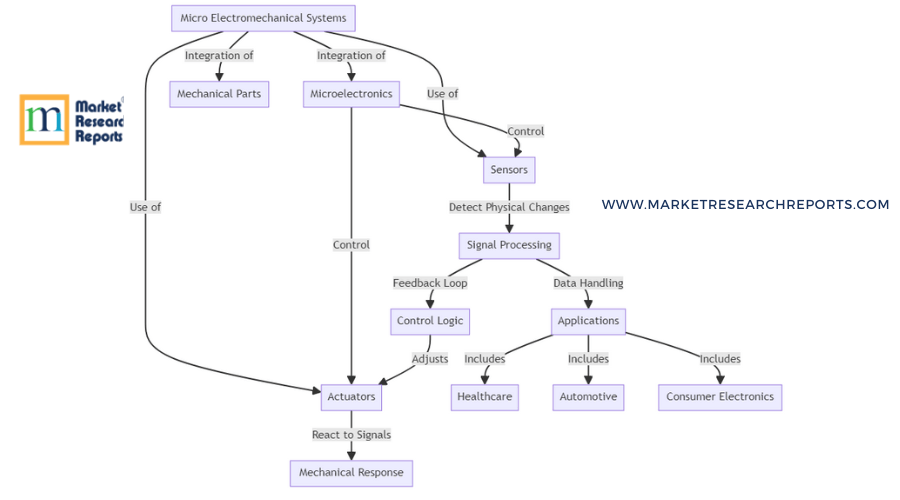Global MEMS Devices Sector on the Rise: Expected to Surpass $1.8 Billion by 2030

Micro Electromechanical Systems (MEMS) represent a critical technology in modern engineering, merging microscopic mechanical and electronic components to create systems that can sense, control, and actuate on the micro-scale. This blog explores the future of MEMS, highlighting their current applications, recent technological advances, and the dual challenges they face from both a technical and macroeconomic perspective.
Micro Electromechanical Systems (MEMS) Functionality:
The diagram below summarizes how Micro Electromechanical Systems (MEMS) work, integrating microelectronics and mechanical components to perform tasks. MEMS use sensors to detect environmental changes and actuators to respond mechanically. Microelectronics control these processes, managing inputs from sensors and outputs to actuators. The signal processing component processes these inputs, which are used to adjust the system's responses via feedback loops. This integrated system allows MEMS to be used in diverse applications like healthcare, automotive, and consumer electronics, highlighting their versatility and functionality in various industries.

1 . Introduction
2 . Applications of MEMS
MEMS are ubiquitous in several fields, reflecting their versatility and adaptability:
- Consumer Electronics: In smartphones, MEMS sensors enable features like screen orientation, image stabilization, and touch-free device operation.
>>Example: The latest iPhones utilize MEMS accelerometers and gyroscopes to support advanced motion detection functionalities, like activity tracking and camera stabilization, enhancing user experience in photography and physical activity monitoring. - Automotive: MEMS contribute to enhanced safety and functionality through applications in airbag deployment systems, tire pressure monitoring, and vehicle stability control.
>>Example: Tesla's Model Y incorporates MEMS sensors for a variety of functions, including airbag deployment systems that adjust the deployment speed based on the severity of a crash, improving safety outcomes. - Healthcare: MEMS devices are crucial in medical implants, diagnostic equipment, and drug delivery systems.
>>Example: The Dexcom G6 Continuous Glucose Monitoring (CGM) System uses MEMS sensors to provide real-time glucose readings directly to patients' smartphones, greatly aiding diabetes management. - Industrial: In sectors like aerospace, MEMS sensors monitor critical systems in real-time to ensure safety and operational efficiency.
>>Example: In aerospace, Boeing 787 aircraft employ MEMS-based pressure sensors to monitor cabin air pressure, enhancing passenger comfort and safety during flights.
3 . Popular Types of MEMS
Micro Electromechanical Systems (MEMS) technologies encompass a wide range of devices, each tailored to specific applications. Below, I'll detail the types you mentioned and introduce additional ones, explaining their functions and providing real-life examples.
MEMS Microphone
MEMS microphones are small, high-performance acoustic sensors that convert sound waves into electrical signals. They are widely used in consumer electronics due to their compact size and excellent sound quality. For example, smartphones like the iPhone utilize multiple MEMS microphones to support features such as noise cancellation and high-quality voice recording.
MEMS Accelerometer
MEMS accelerometers measure acceleration forces, whether caused by gravity or motion, allowing devices to sense orientation, coordinate motion, and detect impacts. A practical application is in fitness trackers and smartphones, where they monitor steps and physical activity, or in automotive systems for vehicle stability control and crash detection.
MEMS Oscillator
MEMS oscillators are used for timing purposes, replacing traditional quartz oscillators with a silicon-based solution that offers higher reliability and better resistance to mechanical shock and temperature variations. They are commonly found in mobile devices, wearables, and IoT devices where precise timing is crucial. An example is the SiTime MEMS oscillators used in wearables for accurate health monitoring and device synchronization.
Additional Types of MEMS Devices
MEMS Gyroscope
MEMS gyroscopes measure the rate of rotation around a particular axis, helping to determine orientation and angular velocity. They are crucial in the stabilization features of drones, cameras, and also in automotive safety systems for features like electronic stability control. For instance, the gyroscope in a DJI drone helps it maintain level flight and stabilize against wind and movement.
MEMS Pressure Sensor
These sensors measure pressure changes within an environment, which can be translated into altitude, flow, or force. They are used in automotive applications for tire pressure monitoring systems (TPMS) and in medical devices like smart inhalers, which use these sensors to monitor breath force and volume, ensuring proper medication dosage.
MEMS Mirrors
MEMS mirrors are tiny, movable mirrors that can adjust light direction and are used in optical applications. One significant use is in pico projectors and laser projectors, allowing for dynamic image resizing and focusing. For instance, Texas Instruments' DLP technology uses MEMS mirrors to project images in digital cinema and conference room projectors.
MEMS Switches
MEMS switches are used to make or break electrical connections mechanically. These are employed in telecommunications for switching signals in networks without loss of quality. They offer advantages in terms of size, power consumption, and reliability over traditional electromagnetic switches.
Each of these MEMS devices plays a crucial role in their respective fields by leveraging the inherent advantages of micro-scale engineering to provide efficiency, precision, and integration capabilities. This versatility ensures that MEMS technology continues to be integral across various industries, driving innovations and improving functionalities in numerous applications.
4 . Recent Developments in MEMS Technology
Recent technological advancements in MEMS have focused on improving performance, miniaturization, and integration capabilities:
- Material Innovation: Researchers are exploring beyond traditional silicon, using materials like polymers and composites to enhance flexibility, durability, and functionality. Researchers at MIT recently developed a new polymer-based MEMS sensor that can withstand extreme temperatures and chemical exposures, making it suitable for use in harsh industrial environments and medical devices.
- Advanced Fabrication Techniques: Techniques such as 3D printing are being adapted to produce MEMS, allowing for more complex structures and cost reductions. A start-up has successfully implemented 3D microprinting to produce MEMS devices with intricate shapes and structures, reducing costs and materials used in traditional photolithography.
- Wireless MEMS Sensors: Development of wireless MEMS sensors that can operate without a battery, harvesting energy from environmental sources. A breakthrough at Stanford University led to the development of a battery-less wireless MEMS sensor that harvests energy from radiofrequency waves, suitable for remote sensing applications in environmental monitoring and infrastructure health.
5 . Technical Challenges
Despite significant advancements, MEMS technology faces several technical challenges:
- Scalability: Scaling down manufacturing processes while maintaining high performance and reliability is a persistent challenge. A company recently faced challenges in scaling the production of a new ultra-sensitive accelerometer, finding it difficult to maintain precision and performance consistency across high-volume batches.
- Integration: As systems become more complex, integrating MEMS with other microscale technologies without compromising functionality becomes more difficult. In integrating MEMS-based sensors with emerging Internet of Things (IoT) devices, companies like Samsung have encountered issues in maintaining device reliability and battery life in multi-functional smart home devices.
- Sensitivity and Stability: Enhancing the sensitivity of MEMS sensors while ensuring long-term stability and reliability in diverse environments remains challenging.The Mars Rover, equipped with MEMS-based environmental sensors, faced challenges related to sensor degradation due to the harsh Martian atmosphere, highlighting the need for improved stability in extreme conditions.
6 . Macroeconomic Challenges: Relevant Examples
- Supply Chain Disruptions: During the COVID-19 pandemic, MEMS manufacturers like Bosch experienced disruptions in the supply of silicon wafers due to lockdowns in supplier countries, affecting production timelines and increasing costs.
- Market Volatility: The automotive sector's shift towards electric vehicles has led to fluctuating demands for MEMS sensors, impacting suppliers who were heavily dependent on traditional automotive markets.
- Investment in Research and Development: Economic recessions have led to budget cuts in R&D spending in the semiconductor industry, affecting the pace of new MEMS developments, as seen during the financial downturns where companies like Intel reduced their R&D budgets.
7 . Future Outlook
- The global Micro-Electromechanical Systems (MEMS) Devices market was valued at approximately USD 1.38 billion in 2023.
- It is anticipated to reach USD 1.85 billion by 2030, witnessing a Compound Annual Growth Rate (CAGR) of 4.3% during the forecast period 2024-2030.
The future of MEMS is promising yet contingent on overcoming existing challenges. Collaborative efforts between industry, academia, and governments are crucial. Additionally, adapting to changing economic landscapes and consumer demands will determine the sustainability and growth of MEMS applications.
8 . References
- Journal of Microelectromechanical Systems
- IEEE Transactions on MEMS
- Nature Microsystems & Nanoengineering
- MarketResearchReports.com





